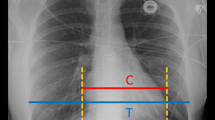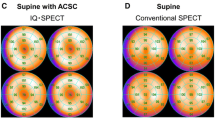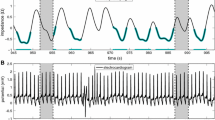Abstract
The most common artifact on thallium scans in our laboratory has been posterior myocardial attenuation, mostly in males. In the past this has been thought due to the position of the diaphragm. Methods: To evaluate this concept, matching chest x-rays were examined and measured. Eleven examples of posterior myocardial attenuation were consecutively pulled from our files and compared to eleven consecutive controls. Results: It was found that the diaphragm did not differ significantly. The ratio of the PA diameter of the chest to chest width was significantly (p < 0.03) less than controls. Conclusions: It is suggested that a male with a flat, wide chest is more prone to posterior myocardial attenuation. If a posterior defect is present in this type of patient it is suggested he be further evaluated to rule out artifact.
Similar content being viewed by others
References
Tamaki N, Yonekura Y, Mukai T et al. Stress Thallium-201 transaxial emission computed tomography: quantitative versus qualitative analysis for evaluation of coronary artery disease. J Am Coll Cardiol 1984: 1213-21.
Segall G, Davis M. Prone versus supine thallium myocardial SPECT: a method to decrease artifactual inferior wall defects. J Nucl Med 1989; 30: 548-55.
Garcia E, Van Train K, Maddahi J et al. Quantification of rotational thallium-201 myocardial tomography. J Nucl Med 1985; 26: 17-26.
Kirsch CM, Doliwa R, Buell U, Roedler D. Detection of severe coronary heart disease with TI-201: comparison of resting single photon emission tomography with invasive arteriography. J Nucl Med 1983; 24: 761-7.
Johnstone D, Wackers F, Berger H et al. Effect of patient positioning on left lateral thallium-201 myocardial images. J Nucl Med 1979; 20: 183-8.
Esquerré JP, Coca F, Martinez S, Guiraud R. Prone decubitus: a solution to inferior wall attenuation in thallium-201 myocardial tomography. J Nucl Med 1989; 30: 398-401.
Wackers F, Sokole E, Samson G, van der Schoot J. Atlas of 201TI myocardial scintigraphy. Clin Nucl Med 1977; 2: 64-74.
Gordon D, Pfisterer M, Williams R, Walaski S, Ashburn W. The effect of diaphragmatic attenuation on 201TI images. Clin Nucl Med 1979; 4: 150-1.
Kiat H, Van Train K, Friedman J et al. Quantitative stress-redistribution thallium-201 SPECT using prone imaging: methodologic development and validation. J Nucl Med 1992; 33: 1509-15.
Friedman J, Van Train K, Maddahi J et al. ‘Upward Creep’ of the heart: a frequent source of false-positive reversible defects during thallium-201 stress-redistribution SPECT. J Nucl Med 1989; 30: 1718-22.
Author information
Authors and Affiliations
Rights and permissions
About this article
Cite this article
Elson, S.H., Clark, W.S. & Williams, B.R. Is ‘diaphragmatic’ attenuation a misnomer?. Int J Cardiovasc Imaging 13, 161–164 (1997). https://doi.org/10.1023/A:1005712922362
Published:
Issue Date:
DOI: https://doi.org/10.1023/A:1005712922362




